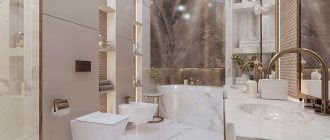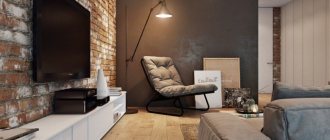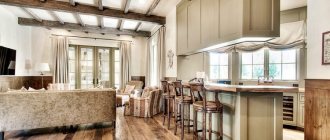The black color of the ceiling is the embodiment of mystery and elegance; it perfectly emphasizes the individuality of the room, and against its background other colors and shades look especially advantageous.
What could a black ceiling look like?
- Stretch (glossy or matte)
- Made of plastic.
- Made from MDF panels.
- Rack mounted.
- Tiled.
- Made from polystyrene tiles.
- Painted.
Important! Black ceilings bring objects closer and absorb height, so they are not recommended for rooms with low ceilings.
Peculiarities
In vaulted structures, in order to make a ceiling in a brick house, an impressive height of the premises is required. Load-bearing walls must provide structural strength and support for the ceiling. In ancient buildings, buttresses were used to provide additional strength. It is impossible to lay bricks on the ceiling in flat floors, since fracture loads are constantly being tested. Therefore, such a solution is only possible in vaulted ceilings. The design does not work on bending, but on compression.
In what styles is a black ceiling appropriate?
- Urbanism.
- Art Deco.
- Minimalism.
- Vanguard
- Modern.
- Classic.
Preliminary preparation
It is necessary to calculate all the expenses necessary to build a rough foundation.
- Ladder;
- Construction trestle;
- Self-tapping screws, screwdriver;
- Sheathing material, heat and vapor barrier;
- Construction level, stationery knife;
- Antiseptic, construction adhesive, fire-fighting compound.
First, I inspect the beams for defects: cracks, chips, curvature, mold, cover the cracks with putty, clean suspicious areas, treat them with an antiseptic, primer, after which they can be painted, if necessary, to do it once and for centuries.
The rough base together with the beams can be treated with an antiseptic with the addition of a teaspoon of universal construction glue so that the mixture does not drip and creates a more durable film.
Black ceiling in the bedroom
In bedrooms, black ceilings are most often used for monochrome interiors. Furniture in pastel colors harmonizes perfectly with rich black. For the bedroom, you should choose a matte canvas so as not to feel discomfort when seeing your reflection. Experiment with lighting: spotlights that imitate the starry sky add romance and coziness.
Sheathing with boards or panels
To hem the ceiling with fiberboard or plastic along beams or counter-lattice, work begins with the most visible wall in the room.
There is a certain procedure for hemming the ceiling in a house with a board:
- The material is measured with a tape measure or locally and cut with a jigsaw from the wrong side.
- It is attached to nails or screws. The first of the boards is fixed at the places where it intersects with the counter-lattice.
- The lining or tongue-and-groove board is hammered with a wooden hammer or block until a complete tongue-and-groove connection is achieved and secured to the outer elements of the sheathing. They are fixed to the intermediate bars one after another in a checkerboard pattern to avoid damage to the cladding.
- After finishing the covering of the entire ceiling surface, the places of contact with the walls are covered with skirting boards made of wood or polymer materials.
- The boards are coated with water-based wood impregnation or a coloring compound.
When fiberboard is planned to be used only for filling niches between beams, the finishing material is attached to pre-nailed bars. At the same time, the filing technology is similar. The same method is used for finishing with plastic panels or MDF, but to prevent chipping, experts recommend pre-drilling small-diameter holes in the products at the attachment point.
Black ceiling in the living room
The living room should have a lot of light and free space so that the ceiling fits into the design. Don't get carried away with fancy chandeliers - they will distract attention and the ceiling will lose its charm. The living room can be decorated not only in black and white, but also experimented with bright and rich shades.
Strengthening and insulation
Strengthening the ceiling structure is necessary when installing natural brick. For this, additional supports are used:
- buttresses;
- flying buttresses;
- pinnacles;
- neurura.
In modern construction, brick does not fully solve the issue of thermal insulation, so high-quality insulation is necessary. Each type of brick has its own thermal conductivity indicators. The higher they are, the more thicker the insulation layer is needed. To insulate the ceiling, the following materials are needed:
- mineral wool;
- fiberglass;
- expanded polystyrene;
- expanded clay
When choosing materials, it is important whether there is an attic. You need to know what direction the ceiling is in - it will be a suspended ceiling, a suspended ceiling, plasterboard, etc. Thermal insulation is done from the floor side, and thereby maintains the height in the rooms. Wooden logs are laid in the concrete floor. If there is no attic, the ceiling is insulated from the inside. You need to glue the surface with glassine and secure it with slabs of mineral wool or penoplex. The plates are installed in a spacer, the foam is glued, and the mineral wool is fixed with dowels.
Black ceiling in the bathroom
Glossy stretch ceilings, as well as plastic or tile finishes, will look most organic. In the bathroom, you should focus on accessories: a mirror in a beautiful frame, interestingly shaped lamps or towel holders - these are the highlights of the interior. The tiles should be plain and unremarkable.
How do they do it?
To make a false ceiling, a structure is created that imitates brickwork. Visually it looks like a brick one and is in no way different from the original. The work is divided into 2 stages:
- preparatory process and creation of the code;
- finishing of the ceiling structure “like brick”.
Creating a vault
There are 2 options:
- Drywall. The profiles must be curved in advance. To finish the vault, putty and primer are used.
- Instead of gypsum board, plywood is used. Some elements must be initially curved.
Brick finish
Gypsum tiles that imitate brick are required. They are glued to the surface of the arch structure. Only high quality glue is used. Purchased tiles are gray or white, so you need to paint the elements in advance. The fold of bricks is chosen at your discretion; the seams between the bricks are filled with jointing mixture. Next, decor is added and lamps are installed.
Black ceiling in the kitchen
The key to success is minimalism in everything. Furniture without pretentious decoration, simple lamps, natural shades and simple shapes. Do not overdo it with decor; the kitchen should remain feeling light and free.
Black goes well with gold, white, red, orange, beige, lilac, turquoise and other shades! Everyone can find the perfect solution for their home!
See also:
- Color combinations in the interior
- Modern interior styles
Construction of a wooden rough covering
Before hemming the ceiling surface, you should understand the layers that make up the interfloor ceiling in a wooden house.
Floor layers from top to bottom:
- The topmost layer is plank flooring, which can be the base for the topcoat or serve as a final finish.
- A vapor barrier membrane is a mandatory layer. Membrane fabric prevents the formation of condensation on wooden structures, prevents the formation of wet areas, mold and fungal growth.
- Thermal insulation. It can be installed in any case, regardless of whether the premises are residential or not on the floor above. If the attic is not residential, the energy efficiency of the house increases; if the attic is residential, the sound insulation of the floors increases.
- Waterproofing. The layer is designed to protect insulation and wooden structures from moisture. If you do not lay waterproofing, humid air and hot steam, rising to the ceiling, will destroy the thermal insulation material - which will reduce the practical characteristics of the product.
- The rough ceiling is the last layer that is finished with the finishing cladding.
Sometimes boardwalks are left unlined, especially when good quality boards are used. If, after arranging the floors, the floor needs to be laid on the floor above, then a layer of vapor barrier is laid on top of the insulation, then the plank base of the floor can be laid.
What is it for?
When building a house with several floors, interfloor ceilings are required. One of them is located at the base of the attic, separating the upper floor from it. In multi-storey buildings, the rough ceiling is made of concrete slabs.
If the house is wooden, then each floor has a complex multi-layer structure. The following must be taken into account:
- Wooden parts are subject to the destructive action of various factors: moisture, insects, fungus and others. The design must provide protection against them.
- Beams may have unevenness. Before creating the finishing layer of the ceiling, you need to take care of leveling the surface.
When planning how to make a rough ceiling in a private house, you need to consider whether there will be another floor or attic on top. In the latter case, it is necessary to provide for the presence of a significant temperature difference.
Rough ceiling on wooden beams Source potolok-exp.ru
Raising a house where to start
But if none of the above methods suits you according to the design features of the house, all that remains is to raise the entire house and then lower the floor level. This type of work needs to be taken quite seriously:
Study the whole house system.
If there is a stove in the house, pay great attention to cutting the pipe. By raising the house, you simultaneously raise the entire ceiling, and therefore the cutting needs to be dismantled. Next you need to determine the approximate weight of the entire structure. When calculating the weight of a wooden house, look at the moisture level of the wood. It is also considered very important what kind of wood your house is built from.
We calculate the weight
Below we provide important indicators of the weight of m3 of different wood. Wood Weight m3 kilogram. Oak 1020 Maple 862 Aspen 793 Larch 833 Aspen 762 Ash 924 Alder 800
But since pine and spruce are considered important building materials, we separately list their weight per m3. At the same time, we give two indicators at once according to these materials with different degrees of drying. No. Name Weight m3 per kilogram. 1 Raw pine 890 2 Raw spruce 790 3 Dry pine 470 4 Dry spruce 450
As can be seen from the above data, the difference is significant.
Our advice is that if you are in doubt about the degree of drying of wood, it is better to take into account the weight limits. With this option, you definitely won't have any problems lifting.
Jacks – too much is not always good
Next we will need jacks. Sometimes it is recommended to use several jacks with a lifting capacity of 5 tons. Using several jacks in parallel will greatly increase the lifting speed and eliminate possible damage to the facing part of the structure. But we recommend that you do things differently and here’s why. Knowing the reality of our life, we doubt that it is not often that anyone will find 4 or 5 similar, serviceable jacks at once, and purchasing them will be an unjustified expense in financial terms. In addition, the cost of them is not so small. When raising a house in the same way, you expect that they will all work very reliably and will not let you down at the most serious moment. But if your hopes are not met, this leads to sad consequences. In addition, installing several lifting devices in parallel increases the possibility that a house on jacks may move to the side.
One jack – the right lift
Lifting with one jack
Unfortunately, this is a reality of life. And therefore we recommend that you take one, but powerful jack:
- Of course, an excellent option would be to use a jack with a lifting capacity of 10 tons, but if this is not possible, you can use a five-ton one.
- The most important thing is not to rush and raise the building as equally as possible, no more than 50 mm per pass.
- In this option, there will be no violations associated with deformation.
- After lifting one side, insert wood wedges of appropriate thickness and move on to the next side.
- When you have made the first pass on all sides, continue climbing further.
Installing wedges - we do it precisely
Just do not place loose wedges under the raised system. Better do this:
- Immediately determine to what height you are going to raise your house
- Set the number of points at which you will climb.
- Set a specific distance to which the lift will be performed in one pass.
- Divide this value by the total lift height.
- Make the required number of wedges for any passage of appropriate thickness.
- If the wedges are made up of several parts, they must be firmly knocked together.
- If a leak in the jack is detected during work, work must be stopped and continued only after replacing the faulty tool.
ATTENTION! - Remember, following these tips is considered to be the key to the safety of people and your safety of those present next to you. Once the house is raised to the required height, you can add the required number of crowns and lower the house. Once the house is raised to the required height, you can add the required number of crowns and lower the house
Once the house is raised to the required height, you can add the required number of crowns and lower the house.
Strengthening vaulted ceilings
The group provides services for strengthening vaulted ceilings with high quality and on time. We work at sites in Voronezh, Voronezh region and regions of the Central Federal District. The services provided are guaranteed for 5 years!
Floors that are formed by joining inclined and arched surfaces are called vaults and are functionally different from ordinary floors. The load on the vaults operates according to the principle of compression and extends to the supporting structures and horizontal thrust (if any). Precise design and professional installation of vaulted ceilings prevent them from collapsing, but sometimes even the strongest vault can become deformed.
In this case, OPORA Group of Companies will come to the rescue, providing its services in Voronezh and the regions of the Central Federal District. The company’s specialists will easily carry out high-quality repairs of any complexity to strengthen the ceiling, using innovative technology based on working with composite materials.
Since the type of repair work depends on what type of deformation the vault is undergoing, at the first stage the nature of the damage is determined and a restoration plan is drawn up based on observations.
Damage typical of vaulted ceilings
The list of damage typical for vaulted ceilings includes:
- cracks;
- loose or falling fragments of brick or stone masonry;
- loss of integrity of masonry mortar.
How to repair a damaged vault and strengthen it?
Regardless of whether the vault is made of brick or stone, the process of its restoration and strengthening is carried out in several stages:
- First of all, the arched vault is cleaned of all kinds of dirt, cement laitance and loose fragments of masonry. To speed up the work and to remove serious contamination, water or sandblasting is used, but steel brushes and a grinder can often be used. Slots and cracks are cleaned by blowing with a stream of compressed air.
- After treatment, the stage of eliminating cracks begins by injecting cement mortar or epoxy resin. The filling composition is selected in accordance with the degree of damage to the arch and the width of the cracks. Anchors are installed, stone or brickwork is repaired, after which all voids are filled with masonry mortar.
- The repair work is followed by the process of strengthening the vault, the methodology for which may vary.
Methods for strengthening the arch
The two most common and simple methods are most often used.
The first method is based on strengthening the ceilings of the vault. This technique involves installing a carbon mesh on a polymer cement solution. This design has a high tensile load-bearing capacity and, despite its strength, remains vapor-permeable for subsequent brickwork. The linear expansion of the composite material is also similar to the expansion of real masonry.
Before installing the reinforcing mesh, a calculation is made to determine the required amount of material and the number of layers, the location of which on the masonry is also included in the calculations. The mesh is securely attached to the masonry and prevents subsequent loosening and falling out of the bricks, at the same time it works in tension when installed on the top of the vault.
The second method involves gunning the structure using a special concrete mortar consisting of cement and hard quartz sand. Shotcrete is the process of mechanized application under pressure of a mixture of air and concrete solution onto the surface to be repaired.
Shotcrete can be applied either wet or dry. Since the shotcrete method depends on the scale of the work being carried out and its specifics, large areas are processed using the wet method, and small areas - using the dry method. Often, when strengthening vaulted floors, the method of dry application of shotcrete is used, since this method has a number of advantages:
- High degree of adhesion to concrete.
- Possibility of stage-by-stage treatment of the surface with gunite (the wet method requires continuous application of concrete mixture to the walls).
- The quality of processing of the repaired surfaces is guaranteed to be high, which allows you to recreate the coating with any required level of strength.
- The ease of operation of the equipment (the hose practically does not become clogged with the dry mixture and, if necessary, can be easily blown out with a stream of compressed air) ensures fast and high-quality work by the craftsmen.
To carry out this manipulation, the working surface is first marked with a “grid”, after which holes are drilled in the arch for the reinforcement and concrete is applied to the already reinforced surface. Thanks to application technology, concrete imitates the texture of real masonry.
Prices for work, terms, guarantee
The price and nature of repair operations, as well as the timing of their implementation, vary from order to order, since the individual is determined after inspecting the object. OPORA Group of Companies, thanks to its individual approach, performs its work with high quality, which is why the company provides a guarantee for a period of 5 years.
You can order the service at any time by contacting the manager in a way convenient for the client: telephone, email are listed on the website page in contacts. Payment after drawing up an estimate with a detailed list of work, the company’s obligations and phased deadlines for repairs. Contact us!
Fill out an application on the website. We will contact you as soon as possible and answer all your questions!
Joining the joints between the bricks of the arched vault
After dismantling the formwork slats, it is necessary to remove small drips of mortar in the area of the seams, after which you can begin jointing. Some craftsmen advise using only a special tool for these purposes, but it is best to do everything the old fashioned way, using a two-hundredth nail. This technique has been tested by personal experience.
PHOTO: YouTube.com Joining is best done using a 200 nail
It is necessary to go over each seam with a two-hundred-piece hat several times, after which the appearance of the vault will be transformed. After all, a lot depends on the accuracy and uniformity of the seams. This work can take quite a long time.
PHOTO: YouTube.com The head of the nail will even out all the seams, making them identical
STRENGTHENING VOUCHED FLOORS
A vault is a type of floor formed by inclined surfaces. A vaulted ceiling works differently than a regular ceiling. Under load, the arch works primarily in compression. The vaults transfer the resulting vertical compression force to the supporting structures. In many types of arches, additional force arises - horizontal (this force is also called thrust). The horizontal thrust may have different meanings or be absent altogether.
Vaults are a characteristic architectural element of temples and old buildings built before the beginning of the 20th century. The main materials for creating vaults are stone and brick.
Typical damage to vaulted ceilings.
Typical damage to arched ceilings are:
2) Dumping out individual bricks or stones.
3) Weathering of masonry mortar.
How to repair and strengthen a damaged brick/stone vault?
The task of repairing and strengthening brick/stone ceiling vaults comes down to a set of measures, namely:
Stage 1
Cleaning the arched vault from loose particles, cement laitance, dust, and dirt. It can be done manually using grinding machines and steel brushes, as well as by sandblasting or water blasting.
Stage 2
Repairing cracks by injection and installing anchors, repairing brickwork, restoring masonry mortar.
Stage 3
Direct measures to strengthen the structure. There are different ways to enhance this. The most convenient and effective are the following 2 methods:
1 way to strengthen vaulted ceilings:
Reinforcement by installing a special carbon mesh on a polymer-cement mortar. This method became known thanks to the developments of such companies as the Italian company Ruredil and the Swiss concern Sika. The method is based on the arrangement of composite reinforcement in the form of a mesh and a binder in the form of polymer cement. The resulting composite material has a high tensile load-bearing capacity, is also vapor-permeable for brickwork and has similar linear expansion characteristics. To strengthen, it is necessary to carry out a special calculation and obtain the amount of material, the number of layers and their location on the brick. The mesh holds the surface of the brickwork together, keeping the bricks from falling out, and also works in tension when glued to the top of the arch.
2 way to strengthen vaulted ceilings:
The main and most popular way to strengthen a brick/stone vault is to gunite structures with special concrete. Shotcrete is the mechanized application of concrete. First, the vault is reinforced, and then a layer of shotcrete is applied, i.e. the result is a kind of shell that follows the shape of the brickwork.
Cost, terms and guarantees.
The list of necessary works, the timing of their implementation and the final cost are determined individually after inspection of the facility. All services provided are guaranteed for a period of 5 years.
Call:
to get detailed advice and call an engineer to the site. Contact SDT - and the reinforcement of the vaulted ceiling will be carried out efficiently and on time!











